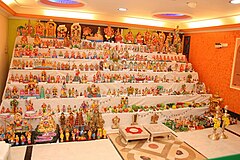| Tamil: Bommai Golu (பொம்மை கொலு) Telugu: Bommala Koluvu (బొమ్మల కొలువు) Kannada: Bombe Habba (ಗೊಂಬೆ ಹಬ್ಬ) Malayalam: Bommakkolu (ബൊമ്മക്കൊലു) | |
|---|---|
 Dasara dolls arrangement | |
| Observed by | Hindus of Tamil Nadu, Andhra Pradesh, Karnataka and few parts of Kerala |
| Type | Hindu |
| Observances | Story telling with dolls, family visiting |
| Begins | Mahalaya |
| Ends | Vijayadashami |
| Related to | Navaratri |
Golu is the festive display of dolls and figurines in South India during the autumn festive season, particularly around the multiday Navaratri (Dussehra, Dasara) festival of Hinduism. These displays are typically thematic, narrating a legend from a Hindu text to court life, weddings, everyday scenes, and miniature kitchen utensils. They are also known as Golu, Gombe Habba, Bommai golu, or Bommala Koluvu.[1][2][3]
Each displayed item in a golu display is sometimes called a golu doll or equivalent. These are typically made by rural artisans from clay and wooden materials then brightly painted. They are generally arranged in an odd number of padis (tiers or steps) to tell a story. Goddess-related themes are common, along with developments such as anticipated wedding within the family and of friends.[2][4] During the golu display season, families and neighbors visit each other with gifts to view and chit-chat over the golu display, share festive foods, and sometimes play music or sing devotional songs together.[4][5] Major Hindu temples such as the Meenakshi Temple in Madurai, arrange elaborate golu displays each year for Navaratri.[6][7][8]
- ^ Unique, artistic, creative: Kolu plans, The Hindu (6 October 2012)
- ^ a b Claus, Peter J.; Diamond, Sarah; Mills, Margaret Ann (2003). South Asian Folklore: An Encyclopedia : Afghanistan, Bangladesh, India, Nepal, Pakistan, Sri Lanka. Taylor & Francis. pp. 443–444. ISBN 978-0-415-93919-5.
- ^ Bado-Fralick, Nikki; Norris, Rebecca Sachs (2010). Toying with God: The World of Religious Games and Dolls. Baylor University Press. pp. 35–36. ISBN 978-1-60258-181-4.
- ^ a b Bornet, Philippe; Burger, Maya (2012). Religions in Play: Games, Rituals, and Virtual Worlds. Theologischer Verlag Zürich. pp. 188–194. ISBN 978-3-290-22010-5.
- ^ Narayanan, Vasudha (2015). Jacobsen, Knut A. (ed.). Routledge Handbook of Contemporary India. Routledge. p. 342. ISBN 978-1-317-40358-6.
- ^ Navarathri celebrations: Meenakshi temple golu display steals the show, The Times of India (6 Oct 2016)
- ^ Crowds throng Madurai Meenakshi temple for 'golu', The Hindu (6 October 2013)
- ^ Gods and gopurams in full glow, The Hindu (1 October 2014)